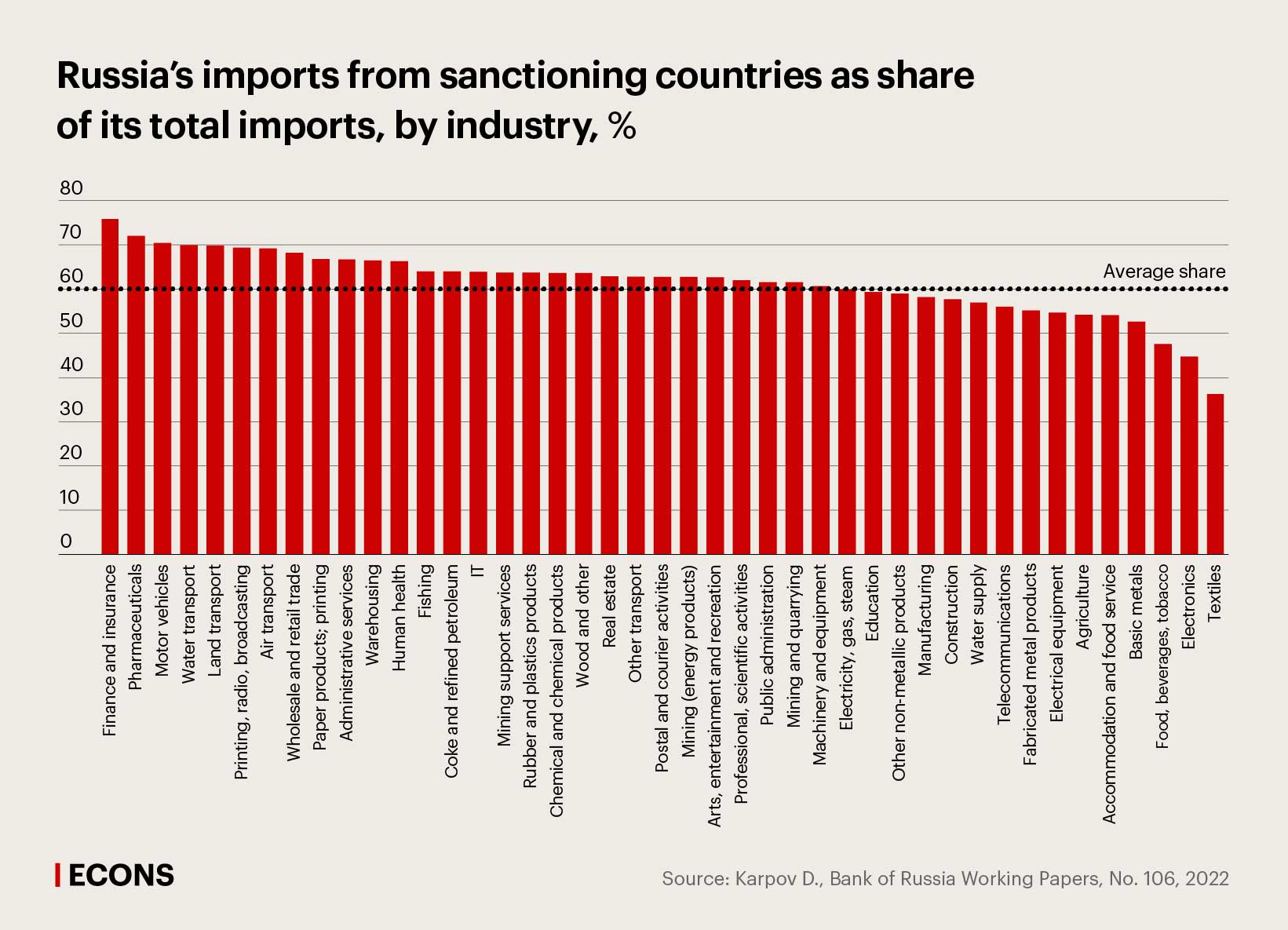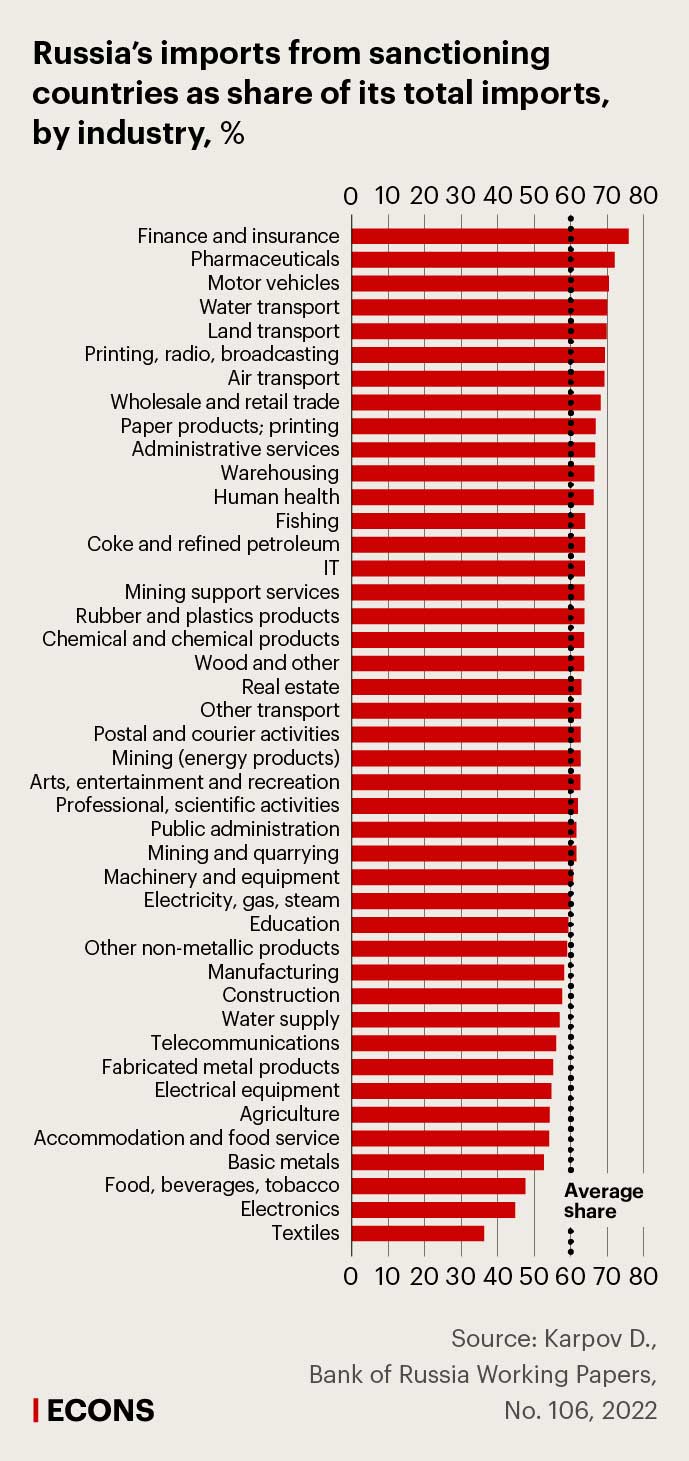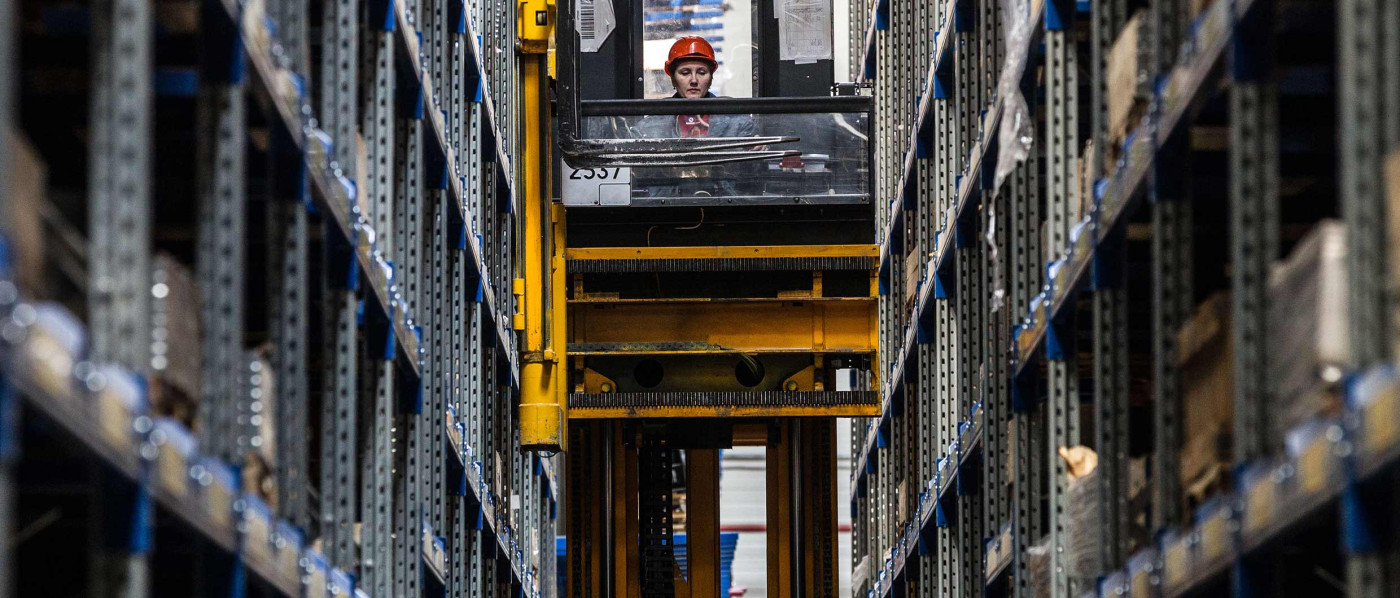Russia’s Import Dependence
The restriction of imports of intermediate goods and services – that is, those that are essential for the domestic production of final products – affects production not only in directly exposed industries, but also in other industries that supply or buy their products. This is why even only one restriction on a specific product or product group can have unexpected implications for the broader economy in terms of output, structure, and relative prices.
In a recent study published as part of the Bank of Russia Working Paper Series, Danila Karpov, lead economist at the Bank of Russia’s Research and Forecasting Department, finds that the import dependence of the Russian economy is relatively low and the share of imports in most industries is lower than in other countries. The key explanation for this could be the low involvement of the Russian economy in global value supply chains and its focus on production of raw materials.



The cross-country comparisons are based on OECD input-output tables for 2015–2018, which show breakdowns of intermediate and final-use goods and services for 45 industries in 66 countries.
Two groups of indicators are calculated to measure the dependence on imports: 1) the proportion of imports in intermediate costs and 2) in final products. Group 1 indicators reflect the proportion of imported products an industry buys from other industries. Group 2 indicators are an industry’s direct foreign imports of goods and services immediately used to manufacture final products, while indirect imports are goods and services which are essential to production and manufactured domestically with the use of imports.
- According to the calculations, the proportion of imports in the intermediate costs (Group 1 indicator) of all industries of the Russian economy, with the exception of professional services and scientific research, is lower than the median in the sample countries. In coke production and oil refining, electrical and gas supply, land and air transport, trade, chemicals, and basic metals, this share is lower than in 90% of countries. It is the highest one in electronics and motor vehicles, textile, and pharmaceutical industries.
- As for direct imports immediately used in the production of domestic products (Group 2 indicator), Russia’s share also proves lower than the median in all industries except for IT, professional services, scientific and technical activities. Among the sectors most dependent on direct imports are motor vehicles (at almost 30%, which is close to the median), electronics (about 20% vs the median of 25%), and rubber and plastics (also about 20% vs the median of slightly below 25%).
- The intersectoral dependence increases when both direct and indirect imports (Group 2) are considered in aggregate. For example, in the motor vehicles indirect imports alone account for over 10% of output value (which suggests a high share of assembly work). This does not change the overall conclusion, however: the import dependence of the sectors of Russia’s economy is lower than the median for all of the sample countries.
- In comparisons of the shares of only non-commodity imports – unlike Russia, many countries have to import energy and raw materials – the gap between the median for all countries and Russia grows smaller. However, for an absolute majority of industries, this share is still below the median (which ranges between almost 30% and about 5% across industries). The exceptions are motor vehicles (where it is above the median), IT, and human health (which are both at the median).
- The picture changes somewhat in comparisons between two separate country samples: those with PPP-adjusted GDPs greater than the median of the OECD sample (as for Russia) and those with populations greater than the median (as for Russia). In these comparisons, the number of industries of the Russian economy whose import dependence is higher than the median of the corresponding limited sample of countries increases to 9 and 19 respectively. Even so, this dependence is still below the median in most industries.
- The share of imports from the countries that have announced anti-Russia sanctions averages 61% of total imports for all sectors of the Russian economy. This varies from 76% in finance to slightly below 40% in textiles and clothing. The real reliance on imports from such economies may be even higher, since products coming in from the states that have no restrictions may still be produced by the firms headquartered in the countries that supported the sanctions.
The author’s analysis indicates that there are several factors behind the relatively low import dependence of Russian industries, including the comparative basis for the calculations. One of the factors is the OECD sample itself, which is dominated by advanced economies that are heavily involved in the global economy. The cross-country median may also be affected by the presence in the sample of small states, which are traditionally highly dependent on imports (Singapore, Luxembourg, Malta, etc.). Furthermore, given that the import of investment is not factored in, the overall import dependence of the Russian economy and its industries may well be underestimated.
However, the author believes that one of the key factors behind Russia’s relatively low dependence on imports is probably its less intensive involvement in global value chains or its involvement chiefly in the early stages (‘at the bottom’ of such chains).
In an integrated global economy, production in individual industries remains highly reliant on imports even if the import dependence of the broader economy is relatively low. For example, although the dependence of the Russian motor vehicles is on average close to the cross-country median, the combination of import restrictions on components and the exit of foreign companies essentially shut the industry down in 2022 (the decline in output was 79% between January and November; at the lowest point, in May, production was down 97%).






